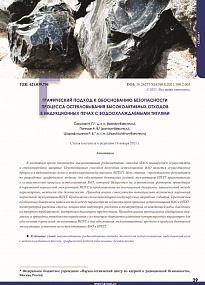В настоящее время захоронение высокоактивных радиоактивных отходов (ВАО) планируется осуществлять в стеклоподобной матрице. Перспективным способом получения остеклованных ВАО является осуществление процесса в индукционных печах с водоохлаждаемыми тиглями (ИПХТ). Цель статьи – представление результатов по разработке графического подхода для обоснования безопасных условий эксплуатации ИПХТ применительно к осуществлению процесса остекловывания ВАО, который базируется на установлении факторов, приводящих к нарушению нормальной эксплуатации ИПХТ, и представлении на совмещенной диаграмме зависимостей между параметрами, важными для безопасности. Проведен анализ совокупности потенциально возможных нарушений нормальной эксплуатации ИПХТ. Предложена схема траекторий постулируемых аварийных событий. Предложены обобщенные диаграммы зависимостей между параметрами осуществления процесса остекловывания ВАО в ИПХТ: температурой расплава стекла, мощностью индуктора, расходом и температурой охлаждающей воды, давлением на напорном трубопроводе, внутренним диаметром трубок тигля. Проведен анализ предлагаемых обобщенных диаграмм, и приведена методология определения с их помощью диапазонов изменения контролируемых параметров для обеспечения нормальной эксплуатации ИПХТ и для обоснования эксплуатационных пределов и пределов безопасной эксплуатации установок по остекловыванию ВАО в ИПХТ.
Ключевые слова: высокоактивные радиоактивные отходы, технология остекловывания, индукционная печь с водоохлаждаемым тиглем, графический подход, обоснование безопасности.
Язык статьи: русский. Cc. 29–39. DOI: 10.26277/SECNRS.2021.100.2.003.
The graphic approach to justification of high-level waste vitrification in cold crucible induction melter
Currently, a high-level waste (HLW) is being planned to be disposеd in a glass matrix. A promising HLW vitrifying method is melting in cold crucible. The purpose of the article is to present a developed graphical approach to justify the safe operational conditions of the HLW vitrification in cold crucible, which is based on the identification of factors leading to disruption of the normal operation. Also the purpose is to represent the dependencies between the parameters important for safety in the combined diagram. The analysis of the possible failures of the normal operation of the cold crucible is carried out. A scheme of trajectories of the failures is proposed. Generalized diagrams of the dependencies between the parameters of the HLW vitrification process in the cold crucible are proposed: the melted matrix temperature, the inductor power, the flow rate and the temperature of the cooling water, the operating pressure in the feeding pipeline and the inner diameter of the crucible pipes. The methodology based on the carried out analysis of the proposed generalized diagrams is presented for determining the deviation ranges of the governing parameters to ensure the normal operation of the cold crucible and to justify the operational limits and conditions of the HLW vitrification in the cold crucible.
Keywords: high-level waste, glass technology, cold crucible induction melter, graphic approach, safety justification.
Article language: Russian. Pp. 29–39. DOI: 10.26277/SECNRS.2021.100.2.003.


